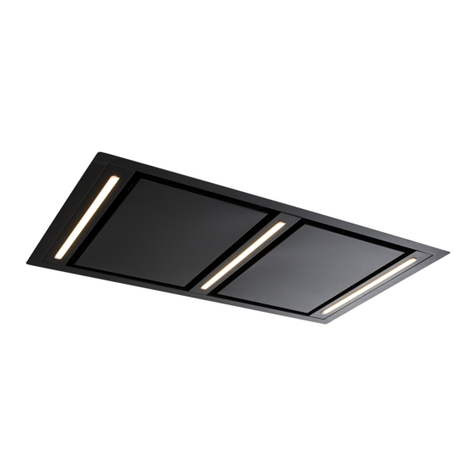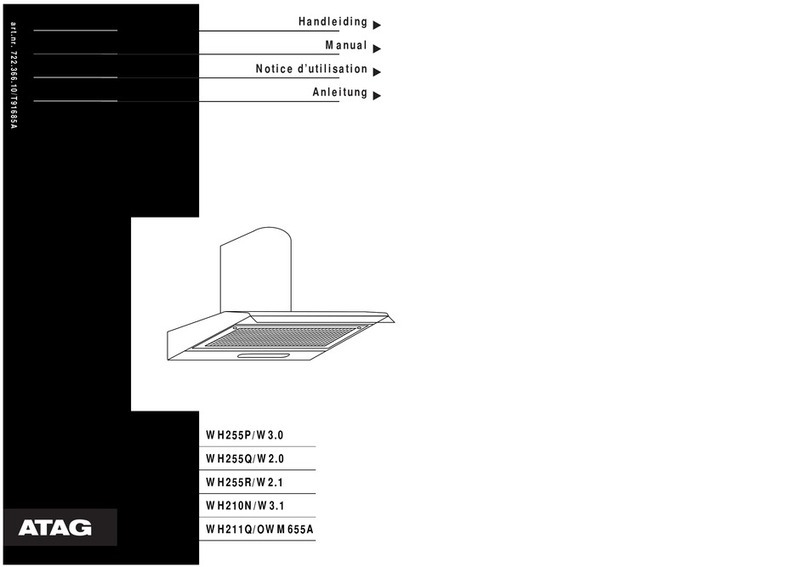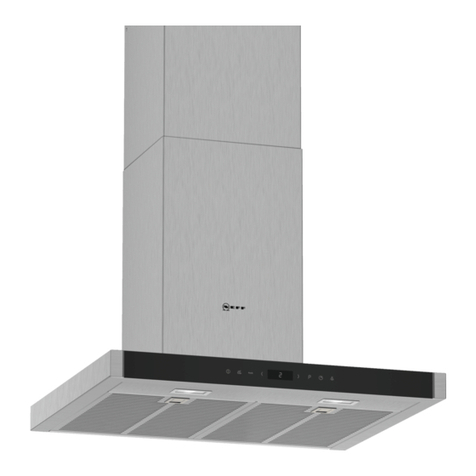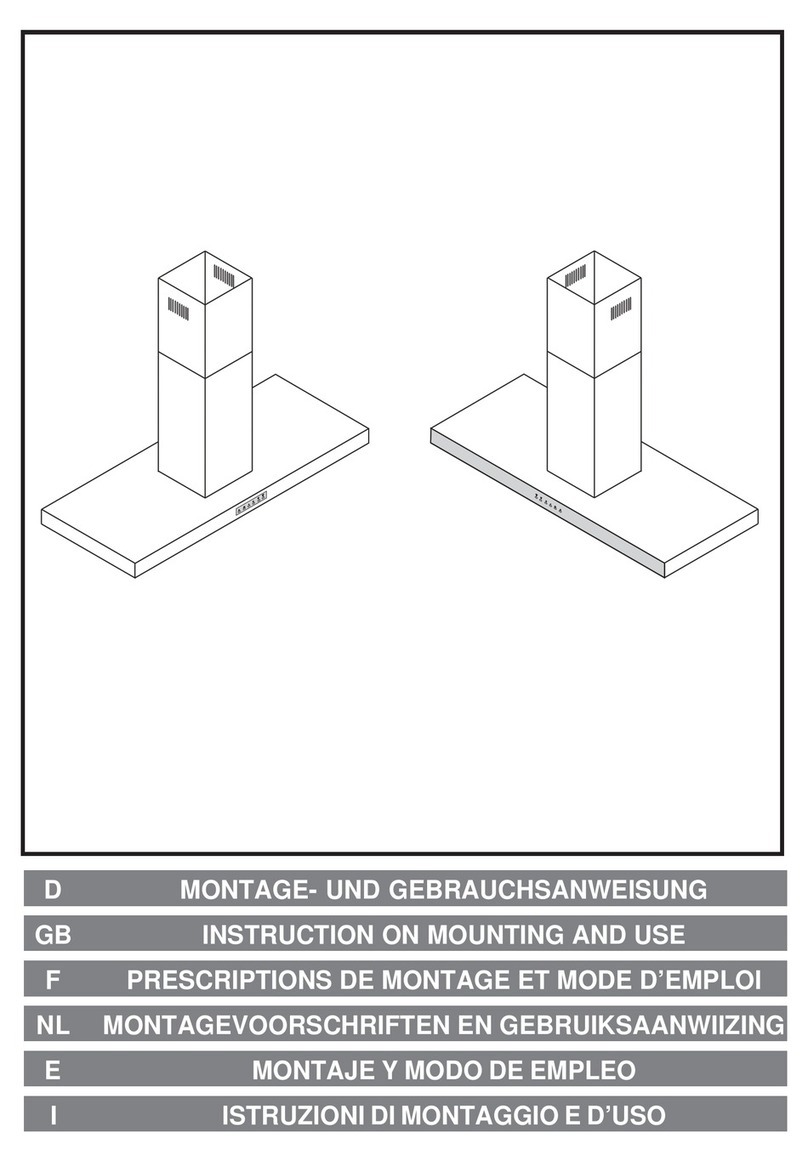Bella PUCBL436SS Installation guide

1
Use, Care, and Installation Guide
Guide d’utilisation, d’entretien et d’installation
Guía de instalación, uso y mantenimiento
READ AND SAVE THESE INSTRUCTIONS
LISEZ CES INSTRUCTIONS ET CONSERVEZ-LES
LEA Y GUARDE ESTAS INSTRUCCIONES
Model: PUCBL436SS LIB0193972
07/23

2
APPROVED FOR RESIDENTIAL APPLIANCES
FOR RESIDENTIAL USE ONLY
READ AND SAVE THESE INSTRUCTIONS
PLEASE READ ENTIRE INSTRUCTIONS BEFORE PROCEEDING.
INSTALLATION MUST COMPLY WITH ALL LOCAL CODES.
IMPORTANT: Save these Instructions for the local electrical Inspector’s use.
INSTALLER: Please leave these Instructions with this unit for the owner.
OWNER: Please retain these instructions for future reference.
Safety warning: Turn o power circuit at service panel and lock out panel, before wiring this appliance.
Requirement: 120 V~, 60 Hz. 15 or 20 A branch circuit
English
Important safety notice............................................................................................................................................................................. 3
Electrical & installation requirements ..................................................................................................................................................... 4
Product dimentions................................................................................................................................................................................... 5
List of materials......................................................................................................................................................................................... 5
Ducting options ......................................................................................................................................................................................... 6
Installation - Ducting version .................................................................................................................................................................. 7
Electrical connection ................................................................................................................................................................................ 9
Complete installation ................................................................................................................................................................................ 9
Description of the hood ............................................................................................................................................................................ 9
Control........................................................................................................................................................................................................ 9
CFM reduction system............................................................................................................................................................................ 10
Maintenance............................................................................................................................................................................................. 10

3
READ AND SAVE THESE INSTRUCTIONS
Internal Blower
(already included with the hood)
HOOD MODEL A W
PUCBL436SS 2.9 350
Important safety notice
CAUTION
FOR GENERAL VENTILATING USE ONLY. DO NOT USE TO
EXHAUST HAZARDOUS OR EXPLOSIVE MATERIALS AND
VAPOURS.
WARNING:
TO REDUCE THE RISK OF FIRE, ELECTRIC SHOCK,
OR INJURY TO PERSONS, OBSERVE THE FOLLOWING:
a) Use this unit only in the manner intended by the manufac-
turer. If you have questions, contact the manufacturer.
b) Before servicing or cleaning unit, switch power o at
service panel and lock the service disconnecting means to
prevent power from being switched on accidentally. When the
service disconnecting means cannot be locked, securely fasten
a prominent warning device, such as a tag, to the service
panel.
WARNING:
TO REDUCE THE RISK OF FIRE, ELECTRIC SHOCK,
OR INJURY TO PERSONS, OBSERVE THE FOLLOWING:
a) Installation work and electrical wiring must be done by
qualified person(s) in accordance with all applicable codes
and standards, including fire-rated construction.
b) Sucient air is needed for proper combustion and ex-
hausting of gases through the flue (chimney) of fuel burn-
ing equipment to prevent back drafting. Follow the heating
equipment manufacturer’s guideline and safety standards such
as those published by the National Fire Protection Association
(NFPA), and the American Society for Heating, Refrigeration
and Air Conditioning Engineers (ASHRAE), and the local code
authorities.
c) When cutting or drilling into wall or ceiling, do not damage
electrical wiring and other hidden utilities.
d) Ducted fans must always be vented to the outdoors.
CAUTION: To reduce risk of fire and to properly exhaust air,
be sure to duct air outside - do not vent exhaust air into
spaces within walls or ceilings, attics or into crawl spaces, or
garages.
WARNING: To reduce the risk of fire or electrical shock,do not
use this fan with any solid-state speed control device.
WARNING: TO REDUCE THE RISK OF FIRE, USE ONLY METAL
DUCTWORK
NOTE: Before any cleaning or maintenance operation, discon
nect hood from the mains by removing the plug or discon-
necting the mains electrical supply.
WARNING:
TO REDUCE THE RISK OF A RANGE TOP GREASE FIRE:
a) Never leave surface units unattended at high settings.
Boilovers cause smoking and greasy spillovers that may ignite.
Heat oils slowly on low or medium settings.
b) Always turn hood ON when cooking at high heat or when
flambeing food (i.e. Crepes Suzette, Cherries Jubilee, Pepper-
corn Beef Flambe’).
c) Clean ventilating fans frequently. Grease should not be
allowed to accumulate on fan or filter.
d) Use proper pan size. Always use cookware appropriate for
the size of the surface element.
NOTE: Always wear work gloves for all installation and mainte-
nance operations
WARNING: To Reduce The Risk Of Fire And Electric Shock, In-
stall This Rangehood Only With Remote Blower Models Rated
Maximum (Current and/or Horsepower) Or Integral Blowers
Manufactured by (Manufacturer’s Name), Model(s) (Name of
Appliance).
See table at the bottom of the page.
Note: a Maximum recommended remote blower rating
WARNING: TO REDUCE THE RISK OF INJURY TO PERSONS
IN THE EVENT OF A RANGE TOP GREASE FIRE, OBSERVE
THE FOLLOWING:a
a) SMOTHER FLAMES with a close-fitting lid, cookie sheet, or
metal tray, then turn o the burner. BE CAREFUL TO PRE-
VENT BURNS. If the flames do not go out immediately, EVAC-
UATE AND CALL THE FIRE DEPARTMENT.
b) NEVER PICK UP A FLAMING PAN – You may be burned.
c) DO NOT USE WATER, including wet dishcloths or towels – a
violent steam explosion will result.
d) Use an extinguisher ONLY if:
■You know you have a Class ABC extinguisher, and you
already know how to operate it.
■The fire is small and contained in the area where it started.
■The fire department is being called.
■You can fight the fire with your back to an exit.
aBased on “Kitchen Fire Safety Tips” published by NFPA.
NOTE: This appliance is not intended for use by persons
(including children) with reduced physical, sensory or mental
capabilities, or lack of experience and knowledge, unless they
have been given supervision or instruction concerning use of
the appliance by a person responsible for their safety.
NOTE: Children should be supervised to ensure that they do
not play with the appliance

4
Electrical & Installation requirements
IMPORTANT
Observe all governing codes and ordinances.
It is the customer’s responsibility:
• To contact a qualied electrical installer.
• To assure that the electrical installation is adequate and in
conformance with National Electrical Code, ANSI/NFPA 70 —
latest edition*, or CSA Standards C22.1-94, Canadian Electrical
Code, Part 1 and C22.2 No.0-M91-latest edition** and all local
codes and ordinances.
• If codes permit and a separate ground wire is used, it is
recommended that a qualied electrician determine that the
ground path is adequate.
• Do not ground to a gas pipe.
• Check with a qualied electrician if you are not sure range hood
is properly grounded.
• Do not have a fuse in the neutral or ground circuit.
IMPORTANT
• Save Installation Instructions for electrical inspector’s use.
• The range hood must be connected with copper wire only.
• The range hood should be connected directly to the fused
disconnect (Or circuit breaker) box through metal electrical
conduit.
• Wire sizes must conform to the requirements of the National
Electrical Code ANSI/NFPA 70 — latest edition*,or CSA
Standards C22.1-94, Canadian Electrical Code Part 1 and
C22.2 No. 0-M91 - latest edition** and all local codes and
ordinances.
• A U.L.- or C.S.A.-listed conduit connector must be provided at
each end of the power supply conduit (at the range hood and at
the junction box).
Copies of the standards listed may be obtained from:
* National Fire Protection Association Batterymarch Park Quincy, Massachusetts 02269
** CSA International 8501 East Pleasant Valley Road Cleveland, Ohio 44131-5575
Use only with rangehood cord-connection kits that have been
investigated and found acceptable for use with this model
rangehood.
a) Do not operate any fan with a damaged cord or plug. Discard
fan or return to an authorized service facility for examination and/
or repair.
b) Do not run cord under carpeting. Do not cover cord with throw
rugs, runners, or similar coverings. Do not route cord under
furniture or appliances. Arrange cord away from trac area and
where it will not be tripped over.
BEFORE INSTALLING THE HOOD
1 For the most ecient air ow exhaust, use a straight run or as
few elbows as possible.
CAUTION: Vent unit to outside of building, only.
2 At least two people are necessary for installation.
3 Fittings material is provided to secure the hood to most types
of walls/ceilings, consult a Qualied Installer, check if they
perfectly t with your cabinet/wall.
4 Do not use ex ducting.
5 COLD WEATHER installations should have an additional
backdraft damper installed to minimize backward cold air ow
and a nonmetallic thermal break to minimize conduction of
outside temperatures as part of the ductwork. The damper
should be on the cold air side of the thermal break. The break
should be as close as possible to where the ducting enters the
heated portion of the house.
6 Make up air: Local building codes may require the use of
Make-Up Air Systems when using Ducted Ventilation Systems
greater than specied CFM of air movement. The specied
CFM varies from locale to locale. Consult your HVAC
professional for specic requirements in your area.
If provided with an electrical plug, connect the hood to a
receptacle that complies with current regulations and placed in
an accessible position. Where an electrical plug is not provided
(direct connection to electrical network) or the plug will not be in
an accessible position after installation, place an approved bipolar
switch in accessible position that provides full disconnection under
overvoltage category III conditions, in accordance with local wiring
rules.

5
Product dimentions
E
AB
C
F
D
Models
PUCBL436SS
A36” (91.4 cm)
B20” (50.8 cm)
C411⁄16” (12 cm)
D2” (5.2 cm)
E31⁄4” x 10” (8.3 x 25.4 cm)
F7” (17.8 cm)
List of materials
Removing the packaging.
CAUTION
Remove carton carefully, wear gloves to protect against sharp edges.
WARNING
Remove the protective lm covering the product before putting into operation.
Supplied Part Pieces Supplied Part Pieces
Hood assembly and LED lamps already
installed
1
Rectangular duct 3 1⁄4” x 10” (8.3 x 25.4 cm)
with back draft dampers
1
4.5x13 mm 4
7” (17.8 cm) round transition
1
3.5x6.5 mm 1
Parts no supplied
Tools/Materials required
• Drill
• 1 1⁄4” (3.0 cm) drill bit
• 1⁄8” (3.0 mm) drill bit for pilot holes
• Pencil
• Wire stripper or utility knife
• Tape measure or ruler
• Caulking gun and weatherproof caulking compound
• Saber or keyhole saw
• Metal snips
• Screwdrivers:
• Phillips
• Flat-blade
Optional accessories and consumable parts
KIT # Part
36” (91.4 cm)
Recirculating Kit ACC02179A

6
Ducting options
Closely follow the instructions set out in this manual.
All responsability, for any eventual inconveniences, damages or res caused by not complying with the instructions in this
manual, is declined.
Ductless (Recirculating) Horizontal Discharge
NOTE:
In cases where it should not be
possible to discharge cooking fumes
and vapour to the outside, purchase:
The Recirculating Kit.
Use a rectangular duct
3 1⁄4” x 10” (8.3 x 25.4 cm)
for discharge of fumes to the
outside.
Vertical Discharge
Use a rectangular duct 3 1⁄4” x 10” (8.3 x 25.4
cm) or use a 7” (17.8 cm) round transition for
discharge of fumes to the outside.
Preparation
Do not cut a joist or stud unless absolutely necessary. If a joist or
stud must be cut, then a supporting frame must be
constructed.
Fittings material is provided to secure the hood to most types of
walls/ceilings.
However, a qualied technician must verify suitability of the
materials in accordance with the type of wall/ceiling.
Before making cutouts, make sure there is proper clearance
within the ceiling or wall for exhaust vent.
CAUTION
For gas cooktop & range installations: Mount the hood so the
bottom is at least 30” (76.2 cm) above the cooking surface.
For electric/induction cooktop & range installations: Mount the
hood so the bottom is at least 24” (61 cm) above the cooking
surface.
There is no maximum mounting height, however, we recommend
mounting the hood no greater than 36” (91.4 cm) above the
cooking surface. For every inch (2.54 cm) above 36” (91.4 cm),
fume and moisture capture eciency diminishes at an increasing
rate and may not deliver an acceptable level of ventilating
performance.
This hood is intended for household use.
PLEASE READ THE INSTALLATION MANUAL FOR SPECIFIC
APPLICATION. Check your ceiling height and hood height
before selecting your hood.

7
Installation- Ducting version
After having choosen the vent option, proceed as follows:
1 Remove the grease lters.
2 Remove the junction box cover. Remove either the top or the
back wiring knockout according the preference and install an
approved wiring clamp.
J-Box cover
Wiring clamp
3 Remove the screws (2) located in the 7” round transition and
keep them in a safe place.
7” round transition
2 screws - 3.5 x 6.5 mm
4 Remove the duct knockouts using a at blade screwdriver
and a small hammer. Use the screwdriver by knocking out
the pannel in similar fashion to a scalpel. Take care of sharp
edges.
ATTENTION
If it is intended to use the hood in the recirculating version do not
remove any duct knockouts and order the necessary
charcoal lter from your supplier.
R1 = Remove rectangular duct knockout only.
R2 = Remove semicircular and rectangular duct knockouts.
Rectangular
vertical discharge
R1 R2
R1
Round vertical
discharge
Rectangular
horizontal discharge
For rectangular ducted discharge installations only
5 Attach exhaust adaptor/damper over knockout opening with
three exhaust adaptor screws. Use the screws
previously removed in step 3.
Make sure damper pivot is nearest to top/back edge of hood.
Remove tape from damper ap.
NOTE: The exhaust adaptor/damper can be installed up to
1 inch on either side of the hood center to accommodate o-
center ductwork. In extreme ocenter installations, one end
of the duct connector may need to be trimmed to clear the
electrical cable clamp.
Exhaust transition/ damper
Top/back edge
Pivot
For round ducted discharge installations only
6 Install 7” (17.8 cm) transition, use the screws previously
removed in step 3.
NOTE: The round transition can be installed up to 1 inch on
either side of the hood center to accommodate o-center
ductwork. In extreme ocenter installations, one end of the
duct connector may need to be trimmed to clear the electrical
cable clamp.
7” round transition

8
Mark holes
1 Select the vent option that your installation will require and
proceed to that section:
Outside top exhaust
(Vertical duct– 3 1⁄4”x 10” Rectangular)
Use the diagram or the hood as a template and mark the locations
on the cabinet for ductwork, electrical wiring and keyhole screw
slots.
Centerline Electrical access
hole (in cabinet
bottom)
Wood shims (recessed
bottom cabinets only)
Hood mounting screws (4)
13 15⁄16” (30” hood)
16 15⁄16” (36” Hood)
13 15⁄16” (30” hood)
16 15⁄16” (36” Hood)
Cabinet front
Cabinet bottom 12 1⁄2”
5 1⁄4”5 1⁄4”
1 1⁄4”
1 1⁄4”
1 1⁄2”
10 1⁄2”
5” Vertical duct
access hole
Outside top exhaust (Only recirculating version)
(Vertical duct–7” Round)
Use the diagram or the hood as a template and mark the locations
on the cabinet for ductwork, electrical wiring and keyhole screw
slots.
Wood shims (recessed
bottom cabinets only)
Hood mounting screws (4)
13 15 16” (30” hood)
16 15 16” (36” Hood) 13 15 16” (30” hood)
16 15 16” (36” Hood)
Cabinet front
Cabinet bottom 12 12”
1 14”
1 12”
10 12”
5”
HOLE
Access hole for
7” round duct
Centerline Electrical access hole
(in cabinet bottom)
8” DIA.
Outside rear exhaust
(Horizontal duct– 3 1⁄4”x 10” Rectangular)
Use the diagram or the hood as a template and mark the locations
on the cabinet for ductwork, electrical wiring and keyhole screw
slots.
Centerline Electrical access hole
(in wall)
Cabinet
bottom
Horizontal duct
access hole
Hood mounting
screws (4)
Cabinet front
13 15 16” (30” hood)
16 15 16” (36” Hood)
13 15 16” (30” hood)
16 15 16” (36” Hood)
1 916”
334
514
”
14”
12716
”
18”
Installation - Recirculating
Use the hood as a template and mark the locations on the cabinet
for the electrical wiring and keyhole screw slots.
Since the hood is to be recirculated (not to be vented outside), do
not cut out any vent openings in the wall or cabinet bottom.
Choose venting option
1 The hood can be set to vent outside or to recirculate air back
into the kitchen. The plastic vent lever is located near the
center of the hood opening.
To vent to the outside, make sure the plastic vent lever is in
the HORIZONTAL position (at against the metal top of the
hood). To recirculate air into the kitchen, make sure the plastic
vent lever is in the VERTICAL position (at against the plastic
blower housing).
NOTE: In order to change the vent lever position, you will need
to pull the lever out slightly to clear the plastic tabs.
Hood shown lying upside down
Set for
outside venting Set for
recirculating
Stop tab
Stop tab
For recessed bottom cabinet only
1 If the cabinets have front, side or back trim, make 2 wood
shims the width of the trim and attach them to the cabinet
bottom recess on both sides.
See previous page for marking locations.
Wood shims
2 Cut holes at marked locations for duct and electrical wiring.
For the vertical duct, cut out 3⁄4” extra toward the front of the
cabinet so you can move the duct freely when installing the
hood. It may also ease installation by cutting the hole 10 1⁄ 2”
instead of 10”.
3 Drive a mounting screw (from the hardware packet) partway
into each center of the narrow neck of the keyhole slots
marked on the cabinet bottom.
4 Fix the wiring conduit to the hood.
5 Slide the hood back against the wall. Tighten the mounting
screws. Be sure the screw heads are in the narrow neck of the
keyhole slot. Connect Ductwork to hood.
5
”

9
Electrical connection
WARNING
ELECTRICAL SHOCK HAZARD.
WARNING
TURN OFF POWER CIRCUIT AT THE SERVICE PANEL
BEFORE WIRING THIS UNIT.
120 V~, 15 OR 20 AMP CIRCUIT REQUIRED.
ELECTRICAL GROUNDING INSTRUCTIONS
THIS APPLIANCE IS FITTED WITH AN ELECTRICAL JUNCTION
BOX WITH 3 WIRES, ONE OF WHICH (GREEN/YELLOW)
SERVES TO GROUND THE APPLIANCE. TO PROTECT YOU
AGAINST ELECTRIC SHOCK, THE GREEN AND YELLOW
WIRE MUST BE CONNECTED TO THE GROUNDING WIRE IN
YOUR HOME ELECTRICAL SYSTEM, AND IT MUST UNDER
NO CIRCUMSTANCES BE CUT OR REMOVED.
Failure to do so can result in death or electrical shock.
• Remove the knockout and the Junction box cover and install
the conduit connector (cULus listed) in junction box.
A
B
A. Knockout
B. Junction box cover
• Run 3 wires; black, white and green ,according to the National
Electrical Code and local codes and ordinances, in 1⁄2” conduit
from service panel to junction box.
A
B
C
D
E
F
A. White wires
B. Black wires
C. CUL listed wire connector
D. Yellow-green (or bare)
ground wire
E. Homepower supply cable
F. UL listed or CSA approved 1⁄2”
strain relief
• Connect black wire from service panel to black or red in
junction box, white to white and green to green-yellow.
• Close and secure junction box cover.
Complete installation
Replace lters.
Check operation of the hood.
If range hood does not operate:
• Check that the circuit breaker is not tripped or the house fuse
blown.
• Disconnect power supply. Check that wiring is correct.
To get the most ecient use from your new range hood, read the
“Maintenance” section.
Keep your Installation Instructions and Use and Care Guide close
to range hood for easy reference.
Description of the hood
2
4
3
3
1
1 Blower and light controls
2 LED lamps
3 Grease lter handle
4 Grease lter
Control
1 2 3 4 5 6
1 Button ON/OFF motor (stand by)
2 Button for low speed (suction power) selection
When ashing, it indicates that you must wash the grease lter.
3 Button for medium speed (suction power) selection
4 Button for high speed (suction power) selection
5 Button for intensive speed (suction power) selection
It lasts 5 minutes then it returns to medium speed (suction
power).
6 Button ON/OFF lighting
Press briey to switch on or o the lighting of the hood.
Press and hold to adjust the intensity of the light.
Indicators of lter saturation:
At regular time intervals, the hood indicates the need of
performing lter maintenance.
Button on with steady light:
Perform grease lter maintenance.
Button ashing:
Perform activated charcoal lter maintenance.
NOTE: Filter saturation signal is visible within the rst minute after
switching o the hood; within this time, the reset of saturation
indicators must be performed.
Reset of lter saturation indicators:
Press and hold the button
Activation of saturation indicator activated charcoal lter:
NOTE: This operation must be performed with the hood o.
This indicator is normally deactivated; press and hold the button
to activate the function: the button lights up with steady light.
To deactivate the function, press and hold the button , the
button lights up ashing.

10
CFM Reduction system
Before operating your hood:
Some States and Provinces of the US & Canada restrict the
maximum exhausting airow of range hoods.
Airow is measured as cubic feet per minute (CFM).
These maximum levels allowed are detailed in the local code
of your area. Please check local codes to nd out if you need
to restrict the maximum airow of your hood. If your local code
mandates a maximum airow level below the maximum airow of
this hood (i.e. 430 CFM), please execute the procedure below to
reduce the maximum airow.
15
1 Turn the motor OFF.
2 Press the ON/OFF (1) and Intensive speed (5) buttons together
for 3 seconds. You will hear a beep and all control lights will
illuminate for 3 seconds.
This action will Disable speeds 3 and 4 and eectively lower
the Maximum airow to >300 CFM.
3 Locate the CFM certication sticker in the hardware pack.
4 Peel and Ax this sticker to a visible area in the blower. This
sticker provides ocial certication to your local
inspector that this hoods maximum airow has been reduced
to >300 CFM.
Maintenance
Cleaning
Do not spray cleaners directly to the control while cleaning the
Hood. The cooker hood should be cleaned regularly (at least
with the same frequency with which you carry out maintenance
of the fat lters) internally and externally. Clean using the cloth
dampened with neutral liquid detergent. Do not use abrasive
products.
DO NOT USE ALCOHOL!
WARNING:
Failure to carry out the basic cleaning recommendations of the
cooker hood and replacement of the lters may cause re risks.
Therefore, we recommend oserving these instructions.
The manufacturer declines all responsibility for any damage to the
motor or any re damage linked to inappropriate maintenance or
failure to observe the above safety recommendations.
Metal grease lter
The lters should be washed frequently. Place metal lters
in dishwasher or hot detergent solution to clean. Let lter dry
thoroughly before replacing it.
Turn o fan and lights. Allow lamps to cool.
1 Remove each lter by pushing down the spring release handle
and then pulling down the lter.
2 Wash metal lters as needed in dishwasher or hot
detergent solution.
3 Reinstall the lter by making sure the spring release handles
are toward the front. Insert metal grease lter into upper track.
4 Pull the spring release handle down.
5 Push up on metal lter and release handle to latch into place.
6 Repeat steps 1-5 for the other lter.
Replacing a LED lamp
The LED lights are replaceable by a service technician only. See
“Who to contact” section in the warranty for service
contact information.
Charcoal lter (Sold separately as accesories)
If the model is not vented to the outside, the air will be
recirculated through disposable charcoal lters that help remove
smoke and odors.
The charcoal lters cannot be cleaned.
They must be replaced.
The charcoal lters are clipped inside of each metal grease lter
(mounting instructions included with charcoal lters kit).
The charcoal lters should be replaced every 4-6 months
(depending on hood usage).
NOTE: DO NOT rinse, or put charcoal lters in an automatic
dishwasher.
NOTE: Charcoal lters are not included with the hood.
They must be ordered from your supplier.
Order the needed kit specifying your hood model and width size.
Charcoal lter placement
Fit the charcoal lter mattress on the upper side of each grease
lter.Use provided springs to x it in place.
NOTE: When removing or replacing the lters, do not remove the
Fixing Springs, simply rotate them upward 90 degrees. This will
allow you to remove or rotate the lter.
Fixing spring
Charcoal filter
Grease filter
top side

11
TWO-YEAR LIMITED WARRANTY
TO OBTAIN SERVICE UNDER WARRANTY
Owner must present proof of original purchase date. Please keep a copy of your dated proof of purchase (sales slip) in order to obtain
service under warranty.
PARTS AND SERVICE WARRANTY
For the period of two (2) years from the date of the original purchase, the supplier will provide free of charge, non consumable parts or
components that failed due to manufacturing defects. During these two (2) years limited warranty, the supplier will also provide free of
charge, all labor and in-home service to replace any defective parts.
WHAT IS NOT COVERED
• Damage or failure to the product caused by accident or act of God, such as, ood, re or earthquake.
• Damage or failure caused by modication of the product or use of non-genuine parts.
• Damage or failure to the product caused during delivery, handling or installation.
• Damage or failure to the product caused by operator abuse.
• Damage or failure to the product caused by dwelling fuse replacement or resetting of circuit breakers.
• Damage or failure caused by use of product in a commercial application.
• Service trips to dwelling to provide use or installation guidance.
• Light bulbs, metal or carbon lters and any other consumable part.
• Normal wear of nish.
• Wear to nish due to operator abuse, improper maintenance, use of corrosive or abrasive cleaning products/pads and oven cleaner
products.
• When the product has not been operated in accordance with the accompanying instructions for use.
WHO IS COVERED
This warranty is extended to the original purchaser for products purchased for ordinary residential use in North America (Including the
United States, Guam, Puerto Rico, US Virgin Islands & Canada).
This warranty is non-transferable and applies only to the original purchaser and does not extend to subsequent owners of the product.
This warranty is made expressly in lieu of all other warranties, expressed or implied, including, but not limited to any implied warranty
of merchantability or tness for a particular purpose and all other obligations on the part of the supplier, provided, however, that if the
disclaimer of implied warranties is ineective under applicable law, the duration of any implied warranty arising by operation of law shall
be limited to two (2) years from the date of original purchase at retail or such longer period as may be required by applicable law.
This warranty does not cover any special, incidental and/or consequential damages, nor loss of prots, suered by the original
purchaser, its customers and/or the users of the Products.
WHO TO CONTACT
To obtain service under warranty or for any service related question, please contact the retailer that sold you this product.
To ensure prompt after-sales service, when you call we will kindly ask you to provide the following information indicated on the
nameplate inside the hood: hood model, 12 NC and date of purchase on original invoice.To access the nameplate, all you have to
do is remove the grease lters.
12NC:___________________________________________________________________________
Hood model:_____________________________________________________________________
Serial No.:_______________________________________________________________________
Date of purchase on original invoice:________________________________________________

12
APPROUVÉ POUR LES APPAREILS DE TYPE RÉSIDENTIEL
POUR UNE UTILISATION RÉSIDENTIELLE SEULEMENT
LISEZ CES INSTRUCTIONS ET CONSERVEZ-LES
VEUILLEZ LIRE CES INSTRUCTIONS AU COMPLET AVANT DE COMMENCER.
L’INSTALLATION DE L’APPAREIL DOIT RESPECTER TOUS LES CODES EN VIGUEUR.
IMPORTANT : Conservez ces instructions an de pouvoir les remettre à l’inspecteur-électricien de votre région.
INSTALLATEUR : Veuillez laisser ces instructions avec l’appareil pour le propriétaire.
PROPRIÉTAIRE : Veuillez conserver ces instructions pour pouvoir vous y référer plus tard.
Avertissement de sécurité : Coupez l’alimentation du circuit dans le panneau électrique et verrouillez le
panneau avant de raccorder les ls de cet appareil.
Exigence : 120 V~., 60 Hz circuit de dérivation de 15 V c.a., 20 Hz, de 15 ou 20 A.
Français
Avis de sécurité important ..................................................................................................................................................................... 13
Exigences electriques et d’Installation ................................................................................................................................................. 14
Dimensions du produit ........................................................................................................................................................................... 15
Liste des pièces....................................................................................................................................................................................... 15
Méthodes d’évacuation........................................................................................................................................................................... 16
Installation- Version à conduit .............................................................................................................................................................. 17
Connexion électrique.............................................................................................................................................................................. 19
Achever l’installation .............................................................................................................................................................................. 19
Description de la hotte............................................................................................................................................................................ 20
Commandes............................................................................................................................................................................................. 20
Système de réduction CFM .................................................................................................................................................................... 20
Entretien................................................................................................................................................................................................... 21
LISEZ CES INSTRUCTIONS ET CONSERVEZ-LES
Ventilateur interne
(déjà inclus avec la hotte)
MODÈLE DE HOTTE A W
PUCBL436SS 2.9 350

13
Avis de sécurité important
ATTENTION POUR UNE UTILISATION GÉNÉRALE DE VENTI-
LATION UNIQUEMENT. NE PAS UTILISER POUR ÉVACUER DES
MATIÈRES ET DES VAPEURS DANGEREUSES OU EXPLOSIVES.
AVERTISSEMENT: POUR RÉDUIRE LES RISQUES D'IN-
CENDIE, DE CHOC ÉLECTRIQUE OU DE BLESSURES AUX
PERSONNES, RESPECTEZ CE QUI SUIT:
a) N'utilisez cet appareil que de la manière prévue par le fabri-
cant. Si vous avez des questions, contactez le fabricant.
b) Avant de procéder à l'entretien ou au nettoyage de l'appa-
reil, coupez l'alimentation au niveau du panneau de service et
verrouillez le dispositif de déconnexion du service afin d'éviter
toute remise sous tension accidentelle. Si le dispositif de
déconnexion ne peut pas être verrouillé, fixez solidement un
dispositif d'avertissement bien visible, tel qu'une étiquette, sur
le panneau de service.
AVERTISSEMENT: POUR RÉDUIRE LES RISQUES D'IN-
CENDIE, D'ÉLECTROCUTION OU DE BLESSURE, RESPECTEZ
LES POINTS SUIVANTS :
a) Les travaux d'installation et le câblage électrique doivent
être eectués par des personnes qualifiées, conformément à
tous les codes et normes applicables, y compris la construc-
tion à indice de résistance au feu.
b) Une quantité d'air susante est nécessaire pour assurer
une bonne combustion et l'évacuation des gaz par le con-
duit (cheminée) des appareils à combustible, afin d'éviter le
refoulement. Suivez les directives du fabricant de l'équipe-
ment de chauage et les normes de sécurité telles que celles
publiées par la National Fire Protection Association (NFPA) et
l'American Society for Heating, Refrigeration and Air Condi-
tioning Engineers (ASHRAE), ainsi que les autorités locales
compétentes en matière de code.
c) Lorsque vous découpez ou percez un mur ou un plafond,
n'endommagez pas le câblage électrique et les autres services
cachés.
d) Les ventilateurs aspirants doivent toujours être ventilés vers
l'extérieur.
ATTENTION: Afin de réduire les risques d'incendie et
d'évacuer correctement l'air, veillez à évacuer l'air à l'extérieur
- ne pas évacuer l'air à l'intérieur des murs ou des plafonds,
dans les greniers ou les vides sanitaires, ou dans les garages.
AVERTISSEMENT: Pour réduire le risque d'incendie ou de
choc électrique, n'utilisez pas ce ventilateur avec un dispositif
de contrôle de vitesse à semi-conducteurs.
AVERTISSEMENT : POUR REDUIRE LE RISQUE D'IN-
CENDIE, N'UTILISEZ QUE DES CONDUITS METALLIQUES.
REMARQUE: Avant toute opération de nettoyage ou d'en-
tretien, débrancher la hotte en retirant la fiche ou en décon-
nectant l'alimentation électrique.
AVERTISSEMENT: POUR REDUIRE LE RISQUE D'INCEND-
IE DE GRAISSE SUR LA CUISINIERE :
a) Ne laissez jamais les appareils de surface sans surveillance à
des réglages élevés. Les ébullitions provoquent des fumées et
des débordements graisseux qui peuvent s'enflammer. Faites
chauer les huiles lentement à feu doux ou moyen.
b) Allumez toujours la hotte lorsque vous cuisinez à feu vif ou
lorsque vous faites flamber des aliments (par exemple, Crêpes
Suzette, Cherries Jubilee, Peppercorn Beef Flambe').
c) Nettoyez fréquemment les ventilateurs. La graisse ne doit
pas s'accumuler sur le ventilateur ou le filtre.
d) Utiliser des casseroles de taille appropriée. Utilisez toujours
des ustensiles de cuisine adaptés à la taille de l'élément de
surface.
REMARQUE: Portez toujours des gants de travail pour-
toutes les opérations d'installation et d'entretien.
AVERTISSEMENT : Pour réduire les risques d'incendie et
de choc électrique, n'installez cette hotte qu'avec des modèles
de souerie à distance d'une puissance maximale (courant et/
ou chevaux) ou des soueries intégrales fabriquées par (nom
du fabricant), modèle(s) (nom de l'appareil).
Voir le tableau à la page 17
Note : a Puissance maximale recommandée pour la souerie
à distance.
AVERTISSEMENT : POUR RÉDUIRE LE RISQUE DE BLES-
SURES AUX PERSONNES EN CAS D'INCENDIE DE GRAISSE
DE POÊLE, RESPECTEZ LES DISPOSITIONS SUIVANTES:a
a) ÉTEIGNEZ LES FLAMMES à l'aide d'un couvercle her-
métique, d'une plaque à biscuits ou d'un plateau métallique,
puis éteignez le brûleur. SOYEZ PRUDENT POUR ÉVITER LES
BRÛLURES. Si les flammes ne s'éteignent pas immédiatement,
EVACUEZ ET APPELEZ LES POMPIERS.
b) Ne ramassez jamais une casserole en feu - Vous pourriez
vous brûler.
c) N'UTILISEZ PAS D'EAU, y compris des torchons ou des ser-
viettes mouillés - une violente explosion de vapeur s'ensuivrait.
d) Utilisez un extincteur UNIQUEMENT si:Vous savez que vous
avez un extincteur de classe ABC et vous savez déjà comment
le faire fonctionner.Le feu est petit et contenu dans la zone où
il s'est déclaré.Les pompiers sont appelés.Vous pouvez com-
battre le feu en tournant le dos à une sortie.
aSelon les "Conseils de sécurité en cas d'incendie dans la cuisine" pub-
liés par la NFPA.
REMARQUE: Cet appareil n'est pas destiné à être utilisé
par des personnes (y compris des enfants) dont les capac-
ités physiques, sensorielles ou mentales sont réduites, ou qui
manquent d'expérience et de connaissances, à moins qu'elles
n'aient reçu une surveillance ou des instructions concernant
l'utilisation de l'appareil de la part d'une personne responsable
de leur sécurité.
REMARQUE : Les enfants doivent être surveillés afin de
s'assurer qu'ils ne jouent pas avec l'appareil.
Le fabricant décline toute responsabilité si les informations
détaillées dans ce manuel pour l’installation, l’entretien et
l’utilisation adéquate du produit ne sont pas observées. Le
fabriquant décline en outre toute responsabilité pour
d’éventuelles blessures dues à des négligences; en outre, la
garantie de l’appareil sera annulée suite à des conditions
d’entretien inappropriées. Cet appareil est fabriqué pour un
usage interne. Ne pas utiliser cet appareil à l’extérieur.

14
Exigences electriques et d’Installation
IMPORTANT
Respectez tous les codes et les ordennances en vigueur.
Le client a la responsabilité de :
• Contacter un électricien-installateur.
• Vérier que l’installation électrique est adéquate et confor-
me avec le Code national de l’électricité, ANSI/ NFPA
70 (la plus récente édition*), ou les normes C22.1-94, Code
canadien de l’électricité, Partie 1 et C22.2 No.0-M91
(La plus récente édition**) de la CSA, ainsi que tous les
codes et les ordonnances de votre région.
• Si le code le permet et que vous utilisez un l de mise
à la terre distinct, il est recommandé de faire vérier le
chemin du l par un électricien.
• Ne pas mettre l’appareil à la terre sur une conduite de gaz.
• Consultez un électricien qualié si vous n’êtes pas
certain que la hotte est mise à la terre correctement.
• N’installez pas un fusible dans le circuit neutre ou le
circuit de mise à la terre.
IMPORTANT
• Conservez ces instructions an de pouvoir les remettre à
l’inspecteur-électricien.
• La hotte doit être câblée uniquement à l’aide de ls de
cuivre.
• Il faut raccorder la hotte directement à une boîte à
fusible ou à un disjoncteur par l’entremise d’une
canalisation électrique en métal.
• Le calibre de l doit être conforme aux exigences du
Code national de l’électricité, ANSI/NFPA 70 (La plus
récente édition*), ou les normes C22.1-94, Code
canadien de l’électricité, Partie 1 et C22.2 0-M91 (La
plus récente édition**) de la CSA, ainsi que tous les
codes et les ordonnances de votre région.
• Il faut prévoir un connecteur de canalisation approuvé
par l’UL ou la CSA à chaque extrémité de la canalisation
d’alimentation (À la hotte et à la boîte de jonction).
Vous pouvez obtenir un exemplaire des normes indiquées en vous adressant à:
* La National Fire Protection Association, Batterymarch Park Quincy, Massachusetts, 02269
** La CSA International, 8501 East Pleasant Valley Road, Cleveland, Ohio, 44131-5575
N’utilisez que des kits de connexion de cordon de hotte qui ont
été examinés et jugés acceptables pour une utilisation avec ce
modèle de hotte.
a) Ne pas faire fonctionner un ventilateur dont le cordon ou
la che est endommagé(e). Mettez le ventilateur au rebut ou
renvoyez-le à un centre de service agréé pour qu’il soit examiné
et/ou réparé.
b) Ne pas faire passer le cordon sous la moquette. Ne pas
couvrir le cordon avec des tapis, des patins ou des revêtements
similaires. Ne pas faire passer le cordon sous les meubles ou les
appareils électroménagers. Placez le cordon à l’écart des zones
de circulation et à un endroit où l’on ne risque pas de trébucher
dessus.
AVANT D’INSTALLER LA HOTTE
1 Pour assurer la ventilation la plus ecace possible,installez la
conduite en ligne droite ou avec le moins decoudes possibles.
1 I ATTENTION La sortie de la conduite de ventilation
doit donner sur l’extérieur.
2 Deux personnes sont nécessaires pour eectuer l’installation.
3 La quincaillerie fournie permet de xer la hotte à la plupart des
murs et des plafonds; consultez un installateur qualié pour
vous assurer que la quincaillerie fournie est adaptée à votre
type de mur ou d’armoire.
4 N’utilisez pas de conduit exible.
5 Dans le cas des endroits sujets aux TEMPÉRATURES
FROIDES, il faut installer un clapet de contre-tirage
supplémentaire an de minimiser le retour d’air froid et
un isolant thermique non métallique an de minimiser la
conduction de la température extérieur dans le conduit. Il faut
placer le clapet du côté de l’air froid de l’isolant thermique.
L’isolant doit être placé le plus près possible de l’endroit où le
conduit entre dans la partie chauée de la maison.
6 Air d’appoint : Le code du bâtiment de votre région peut
exiger l’utilisation d’un système d’air d’appoint si vous utilisez
un système de ventilation à conduit dont le mouvement d’air
dépasse un certain nombre de CFM. Le nombre de pi3/min
varie d’une région à l’autre. Consultez un professionnel de
CVC pour connaître les exigences précises de votre région.
Si la hotte est munie d’une che électrique, la raccorder à un
réceptacle conforme à la réglementation en vigueur et placé en
position accessible. Si la hotte n’est pas équipée d’une che
électrique (raccordement direct au réseau électrique) ou si la che
ne sera pas en position accessible après l’installation, placez
un interrupteur bipolaire homologué en position accessible qui
assure une déconnexion totale dans des conditions de surtension
de catégorie III, conformément aux règles de câblage locales.

15
Dimensions du produit
E
AB
C
F
D
Modèles
PUCBL436SS
A36” (91.4 cm)
B20” (50,8 cm)
C4 11⁄16” (12 cm)
D2” (5,2 cm)
E31⁄4” x 10” (8,3 x 25,4 cm)
F7” (17,8 cm)
Liste des pièces
Retirer les pièces de leur emballage.
ATTENTION
Enlever délicatement le carton, porter des gants pour se protéger des bords coupants.
AVERTISSEMENT
Enlever le lm de protection recouvrant le produit avant de commencer l’opération.
Pièces Fournies Quantité Pièces Fournies Quantité
Assemblage hotte avec lampes DEL
1
Module connecteur de conduit rectangulaire
de 31⁄4” x 10” (8,3 x 25,4 cm)
1
4,5x13 mm 4
Raccord circulaire 7” (17,8 cm)
1
3,5x6,5 mm 1
Pièces non fournies
Outils nécessaires
• Perceuse
• Foret de 1 1⁄4” (3,0 cm)
• Foret de 1⁄8” (3,0 mm) pour avant-trous
• Crayon
• Pince à dénuder ou couteau utilitaire
• Ruban á mesurer ou règle
• Pistolet à calfeutrage et composé de calfeutrage résistant aux
intempéries
• Tournevis à lame plate
• Tournevis Philips
• Scie sauteuse ou scie à guichet
• Cisaille de ferblantier
Accessoires optionnel
KIT # Pièce
36” (91.4 cm)
Kit de recyclage ACC02179A

16
Méthodes d’évacuation
Suivez à la lettre les directives présentées dans ce manuel.
Le fabricant refuse toute responsabilité en ce qui a trait à tout préjudice, dommage ou incendie causé par la non observation des direc-
tives contenues dans le présent manuel.
Version sans conduit (Recyclage) Évacuation horizontale
REMARQUE:
Dans le cas de la version sans
conduit (à recyclage) seulement:
procurez-vous la trousse de
conversion en hotte à recyclage.
Utiliser un conduit
rectangulaire de 31⁄4” x 10”
(8,3 x 25,4 cm)
Évacuation verticale
Utiliser un conduit rectangulaire de 31⁄4” x 10”
(8,3 x 25,4 cm) ou utiliser un conduit circulaire de
7” (17,8 cm)
Préparation
Ne coupez pas une solive ou un montant à moins qu’il soit
absolument nécessaire de le faire. Si vous devez couper une
solive ou un montant, vous devez construire un cadre de soutien.
La quincaillerie fournie permet de xer la hotte à la plupart des
murs et des plafonds.
Vous devez cependant demander à un technicien qualié de
vérier la solidité des matériaux selon le type de mur ou de
plafond.
Avant de couper, assurez-vous qu’il y a un dégagement susant
dans le plafond ou le mur pour passer la conduite de sortie.
ATTENTION
Pour l’installation des cuisinieres à gaz: Installer cette hotte de
sorte que le rebord inférieur est à 30” (76,2 cm) au-dessus de la
surface de cuisson.
Pour l’installation des cuisinieres électriques / induction: Installer
cette hotte de sorte que le rebord inférieur est pas moins de 24”
(61 cm) sur la surface de cuisson.
Il est recommandé d’installer cette hotte plus de 36” (91,4 cm)
au-dessus de la surface de cuisson. Par pouce (2,54 cm)
supérieure à 36 (91,4 cm) diminuera l’ecacité de la capture de la
fumée et de l’humidité, et la performance de ventilation.
S’IL VOUS PLAÎT LIRE L’INSTALLATION POUR UNE
INSTALLATION SPÉCIFIQUE. Avant de choisir la hotte, vériez la
hauteur du plafond et la hauteur maximale de la hotte.

17
Installation- Version à conduit
Après avoir choisi le type d’évacuation, procéder comme suit:
1 Enlever les ltres à graisse.
2 Enlever le couvercle de la boîte de dérivation. Enlever la
partie supérieure ou arrière prédécoupée suivant votre
préférence et installer une attache électrique homologuée.
Couvercle de
la boite de
dérivarion
Attache
électrique
homologuée
3 Retirer les vis (2) situées dans le raccord circulaire et
gardez-les dans un endroit sûr.
Raccord circulaire 7”
2 vis - 3,5 x 6,5 mm
4 Enlever les parties prédécoupées pour les conduits en
utilisant un n tournevis et un petit marteau.
Utiliser le tournevis à la façon d‘un biseau. Faire attention aux
parties blessants.
ATTENTION
En cas d’utilisation de la hotte avec recyclage d’air, ne pas
enlever les parties prédécoupées pour les conduits et commander
les ltres à charbon nécessaires chez votre revendeur.
R1 = Enlever uniquement les parties prédécoupées pour les
conduits rectangulaires.
R2 = Enlever les parties prédécoupées pour les conduits
circulaires et rectangulaires.
Décharge rectan-
gulaire vertical
R1 R2
R1
Décharge circulaire
vertical
Décharge rectangulaire
horizontal
Pour les évacuations avec conduits rectangulaires
uniquement (autrement, passer à l’étape suivante)
5 Attacher le joint ou la soupape d’évacuation sur l’ouverture
préformée à l’aide des trois vis prévues à cet eet. Utiliser
les vis précédemment retirées à l’étape 3. S’assurer que les
éléments soient le plus proche possible de la partie arrière en
haut de votre hotte.
Enlever la protection du clapet.
REMARQUE: Le joint/soupape d’évacuation peut être installé
jusqu’à 2,5 cm (1 po) de part et d’autre du centre de la hotte
pour permettre le décentrage des conduits. Dans le cas de
systèmes d’évacuation très décentrés, la partie terminale du
conduit d’évacuation peut être modiée pour dégager l’attache
du l électrique.
Joint/soupape d’évacuation
Partie arriére en
haut
Pivot

18
Pour les évacuations avec conduits circulaires uniquement
6 Installer le raccord circulaire des conduits d’évacuation à l’aide
des vis. Utiliser les vis précédemment retirées à l’étape 3.
REMARQUE: Le raccord circulaire peut être installé jusqu’à
2,5 cm (1 pouce) de part et d’autre du centre de la hotte
pour permettre le décentrage des conduits. Dans le cas de
systèmes d’évacuation très décentrés, la partie terminale du
conduit d’évacuation peut être modiée pour dégager l’attache
du l électrique.
Raccord circulaire 7”
Emplacement des trous
Sélectionner le type d’évacuation choisi pour votre hotte et
procéder:
Évacuation extérieure par le dessus de la hotte
(Conduit vertical rectangulaire de 3 1⁄4” x 10”)
Utiliser le schéma ou la hotte comme patron et indiquer sur
l’armoire l’emplacement des conduits, des ls électriques et les
fentes réglables pour les vis.
Axe du
centre
Accès au circuit électrique
(à l´arrière du meuble)
Morceaux en bois (pour armoire
encastrée uniquement)
Vis de fixation (4)
13 15⁄16” (modèle 30”)
16 15⁄16” (modèle 36”) 13 15⁄16” (modèle 30”)
16 15⁄16” (modèle 36”)
Face avant de l’armoire
Fond de l`armoire 12 1⁄2”
5 1⁄4”5 1⁄4”
1 1⁄4”
1 1⁄4”
1 1⁄2”
10 1⁄2”
5” Trou pour le passage
du conduit vertical
Évacuation extérieure par le dessus de la hotte
(Conduit vertical circulaire de 7”)
Utiliser le schéma ou la hotte comme patron et indiquer sur
l’armoire l’emplacement des conduits, des ls électriques et les
fentes réglables pour les vis.
Axe du
centre
Accès au circuit électrique
(à l´arrière du meuble)
Morceaux en bois (pour armoire
encastrée uniquement)
Vis de fixation (4)
13 15⁄16” (modèle 30”)
16 15⁄16” (modèle 36”)
13 15⁄16” (modèle 30”)
16 15⁄16” (modèle 36”)
12 1⁄2”
1 1⁄4”
Face avant de l’armoire
1 1⁄2”
10 1⁄2”
Fond de l`armoire
5”
Trou pour le passage du
tube circulaire de 7”
Trou de 8”
de diamètre
Évacuation extérieure par le dessus de la hotte
(Conduit vertical circulaire de 7”)
Utiliser le schéma ou la hotte comme patron et indiquer sur
l’armoire l’emplacement des conduits, des ls électriques et les
fentes réglables pour les vis.
Axe du
centre
Morceaux en bois (pour armoire
encastrée uniquement)
Face avant
del’armoire
Trou pour le passage
du conduit horizontal
Vis de
fixation (4)
Accès au circuit
électrique (dans le mur)
Fond de
l`armoire
13 15⁄16” (modèle 30”)
16 15⁄16” (modèle 36”)
3 3⁄4”
1⁄8” 19⁄16”
127⁄16”
51⁄4”51⁄4”
13 15⁄16” (modèle 30”)
16 15⁄16” (modèle 36”)
Installation- Recyclage d’air
Utiliser le schéma ou la hotte comme patron et indiquer sur
l’armoire l’emplacement des ls électriques et les fentes réglables
pour les vis.
Puisque la hotte va recycler l’air (il n’y a pas d’évacuation vers
l’extérieur), ne pas prévoir d’ouverture dans le mur ou l’armoire
pour le passage des conduits.
Sélectionner le type d’évacuation choisie pour votre hotte
1 La hotte peut être installée pour évacuer l’air à l’extérieur
ou pour recycler l’air dans la cuisine. Le levier de ventilation
en plastique est situé près du centre de l’ouverture de la
hotte. Pour évacuer vers l’extérieur, s’assurer que le levier
de ventilation en plastique est en position HORIZONTALE
(à plat contre la partie supérieure métallique de la hotte).
Pour recycler l’air dans la cuisine, s’assurer que le levier de
ventilation en plastique est en position VERTICALE (à plat
contre la protection en plastique de la souerie).
REMARQUE: Pour changer la position du levier de ventilation,
il est nécessaire de pousser légèrement le levier pour dégager
les parties en plastique.

19
Pour programmer
l´evacuation extèrieure
Pour programmer
le recyclage d´air
Bloquer
l´attache
Bloquer
l´attache
Pour armoire encastrée seulement
1 Si les armoires ont une garniture à l’avant, sur le côté ou
à l’arrière, réaliser 2 morceaux de bois de la largeur des
garnitures et les attacher à l’armoire encastrée sur les 2
côtés. Pour les emplacements des marques, se référer
aux indications à la page précédente.
Morceaux in bois v
2 Réaliser les trous pour les conduits et les ls électriques
aux emplacements indiqués. Pour le conduit vertical,
agrandir le trou de 3⁄4” vers le devant de l’armoire pour
pouvoir bouger le conduit plus librement lors de la mise
en place de la hotte. L’installation sera également plus
facile si le trou fait 10½” au lieu de 10”.
3 Serrer une vis de xation (se trouvant dans le kit de
montage) dans chaque petite ouverture des crochets
marqués sur le fond de l’armoire.
4 Raccorder le tube électrique à la hotte.
5 Replacer la hotte contre le mur. Serrer les vis de xation.
S’assurer que la tête des vis est bien dans la partie plus étroite
des fentes des crochets. Raccorder les conduits à la hotte.
Connexion électrique
AVERTISSEMENT
RISQUE DE CHOC ÉLECTRIQUE.
AVERTISSEMENT
ETEIGNEZ CIRCUIT D’ALIMENTATION AU NIVEAU DU
PANNEAU DE SERVICE AVANT DE RACCORDER CET
APPAREIL. EXIGENCE 120 V~, CIRCUIT DE DÉRIVATION DE
15 V~, 20 HZ, DE 15 OU 20 A.
INSTRUCTIONS DE MISE À LA TERRE
INSTRUCTIONS DE MISE À LA TERRE CET APPAREIL
EST MUNI D’UNE BOÎTE DE JONCTION ÉLECTRIQUE À
TROIS FILS, DONT L’UN (VERT/JAUNE) SERT À METTRE
L’APPAREIL À LA TERRE. POUR VOUS PROTÉGER CONTRE
LES CHOCS ÉLECTRIQUES, VOUS DEVEZ RACCORDER
LE FIL VERT/JAUNE AU FIL DE MISE À LA TERRE DU
SYSTÈME ÉLECTRIQUE DE VOTRE MAISON. EN AUCUNE
CIRCONSTANCE CE FIL DOIT ÊTRE COUPÉ OU ENLEVÉ.
Le fait de ne pas respecter cette directive peut entraîner la
mort ou un choc électrique.
• Retirez l’alvéole défonçable et le couvercle de la boîte de
jonction et installez un connecteur de canalisation (Listé dans
cULus) dans la boîte de jonction.
A
B
A. Opercule arrachable
B. Couvercle du boîtier
• Passez trois ls, le noir, le blanc et le vert, en respectant les
normes du code national de l’électricité, ainsi que les codes
et les ordonnances en vigueur dans votre région, dans une
canalisation de 1⁄2 po, du panneau de service à la boîte de
jonction.
A
B
C
D
E
F
A. Fils blancs
B. Fils noirs
C. Connecteur de ls répertorié CUL
D. Fil de terre jaune-vert (ou nu)
E. Câble d’alimentation domestique
F. Serre-ls de 1⁄2” répertorié UL ou
approuvé CSA
• Raccordez le l noir du panneau de service au l noir ou rouge
de la boîte jonction, le blanc avec le blanc et le vert avec le
vert/jaune.
• Fermez le couvercle de la boîte de jonction.

20
Achever l’installation
Replacer les ltres.
Vérier que la hotte fonctionne.
Si la hotte ne fonctionne pas:
• Vériez que le disjoncteur ne s’est pas déclenché ou que
le fusible n’est pas grillé.
• Débranchez l’alimentation. Vériez que les raccords
électriques ont été eectués correctement.
Pour utiliser votre nouvelle hotte de façon optimale, lisez la
section intitulée “Entretien“.
Gardez vos instructions d’installations et d’utilisation près de la
hotte pour pouvoir vous y référer facilement.
Description de la hotte
2
4
3
3
1
1 Boutons de commande du ventilateur et des lampes
2 DEL lampes
3 Poignée pour le ltre
4 Filtre à graisse
Commandes
s
1 2 3 4 5 6
1 Bouton OFF moteur (stand by)
2 Bouton de sélection vitesse (puissance d’aspiration)
basse – le clignotement indique la nécessité de laver le ltre à
graisse.
3 Bouton de sélection vitesse (puissance d’aspiration)
moyenne.
4 Bouton de sélection vitesse (puissance d’aspiration) haute.
5 Bouton de sélection vitesse (puissance d’aspiration) intensive
– durée de 5 minutes et ensuite la hotte revient à la vitesse
(puissance d’aspiration) moyenne.
La touche clignote dans pour indiquer la temporisation de la
vitesse.
6 Bouton ON/OFF lumière
Appuyez brièvement pour allumer ou éteindre l’éclairage de la
plaque de cuisson. Maintenez la touche enfoncée pour régler
l’intensité de la lumière.
Indicateurs de saturation ltres:
À intervalles réguliers, la hotte indique la nécessité d’eectuer
l’entretien des ltres.
Touche éclairée à lumière xe:
Eectuer l’entretien du ltre à graisse.
Touche éclairée clignotante:
Eectuer l’entretien du ltre à charbon actif.
Remarque: L’indication de la saturation des ltres est visible
pendant la première minute après l’arrêt de la hotte; dans
ce délai, la réinitialisation des indicateurs de saturation doit être
eectuée.
Reset indicateurs de saturation filtres:
Appuyez longuement sur la touche
Activation indicateur de saturation ltre à charbon actif
Remarque: Cette opération doit être eectuée avec la hotte
éteinte. Cet indicateur est normalement désactivé, appuyez
longuement sur la touche pour activer la fonction:
la touche est éclairée à lumière xe.
Pour désactiver la fonction, appuyez longuement sur la
touche : la touche est éclairée à lumière clignotante.
Système de réduction CFM
Avant d’utiliser votre hotte de cuisine:
Certains États et provinces des États-Unis et du Canada limitent
l’évacuation d’air maximal des hottes de cuisine.
L’évacuation d’air est mesuré en pieds cubes par minute (CFM).
Ces niveaux maximaux autorisés sont détaillés dans le code local
de votre région. Vériez les codes locaux pour savoir si vous
devez restreindre le ux d’air maximum de votre hotte. Si votre
code local exige un niveau maximal d’évacuation d’air au-dessous
du maximal d’évacuation de ce hotte (c.-à-d. 430 CFM), exécutez
la suivant procédure pour réduire le débit d’air.
15
1 Désactiver le moteur.
2 Appuyez sur les touches ON / OFF (1) et Vitesse Intensive
(5) ensemble pendant 3 secondes.
Vous entendrez un bip et toutes les lumières de contrôle
s’allumeront pendant 3 secondes. Cette action désactive les
vitesses 3 et 4 et diminuer le ux d’air maximum à> 300 CFM.
3 Localisez l’étiquette de certication CFM dans le sac de
matériel.
4 Pelez et attachez cette étiquette à une zone visible dans le
hotte. Cette étiquette garantit à votre inspecteur local que le le
ux d’air maximum de cette hotte a été réduit à > 300 CFM.
Table of contents
Languages:
Other Bella Ventilation Hood manuals
Popular Ventilation Hood manuals by other brands

Beko
Beko CHP 30100 CF user manual

KitchenAid
KitchenAid 30" Freestanding Range Installation instructions and use and care guide

Gaggenau
Gaggenau VL 040 714 installation instructions

Bosch
Bosch DWK096751B Operating and installation instructions
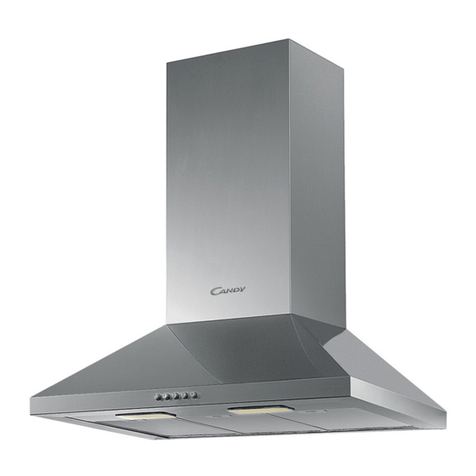
Candy
Candy CCE 16/1 X User instructions

Bosch
Bosch DFS067K51 User manual and installation instruction
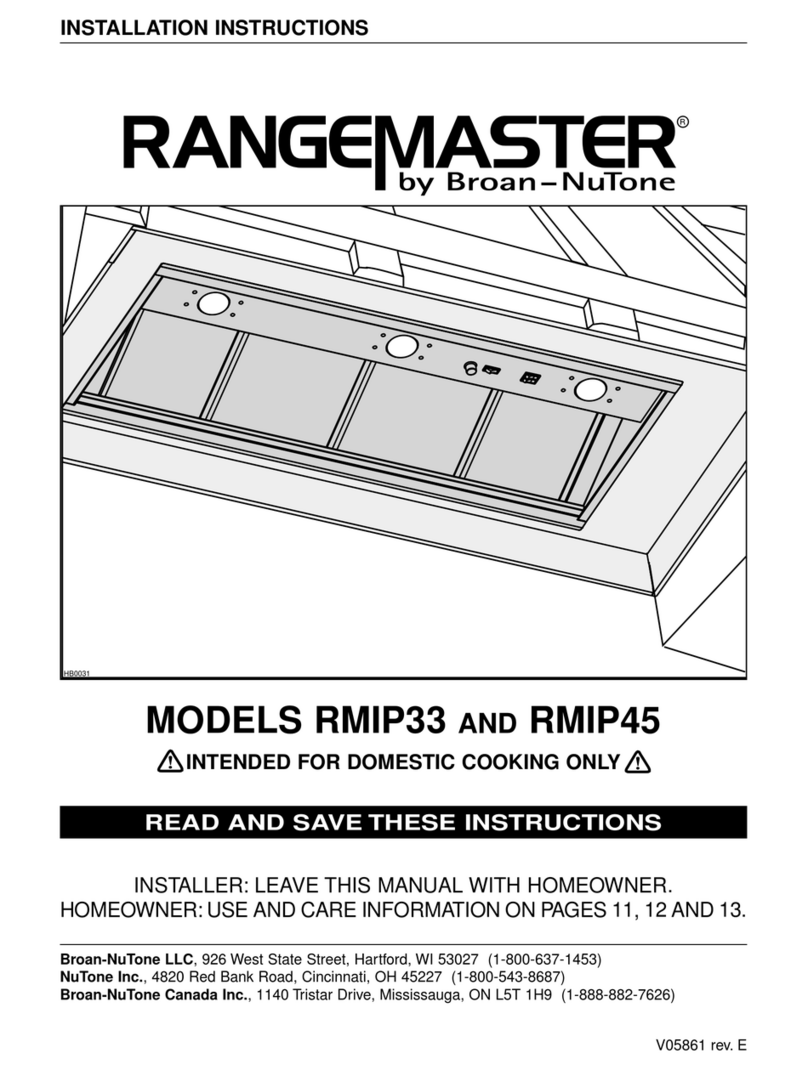
NuTone
NuTone RMIP33 installation instructions

Trade-wind
Trade-wind P7200 Series Installation instructions & use & care guide
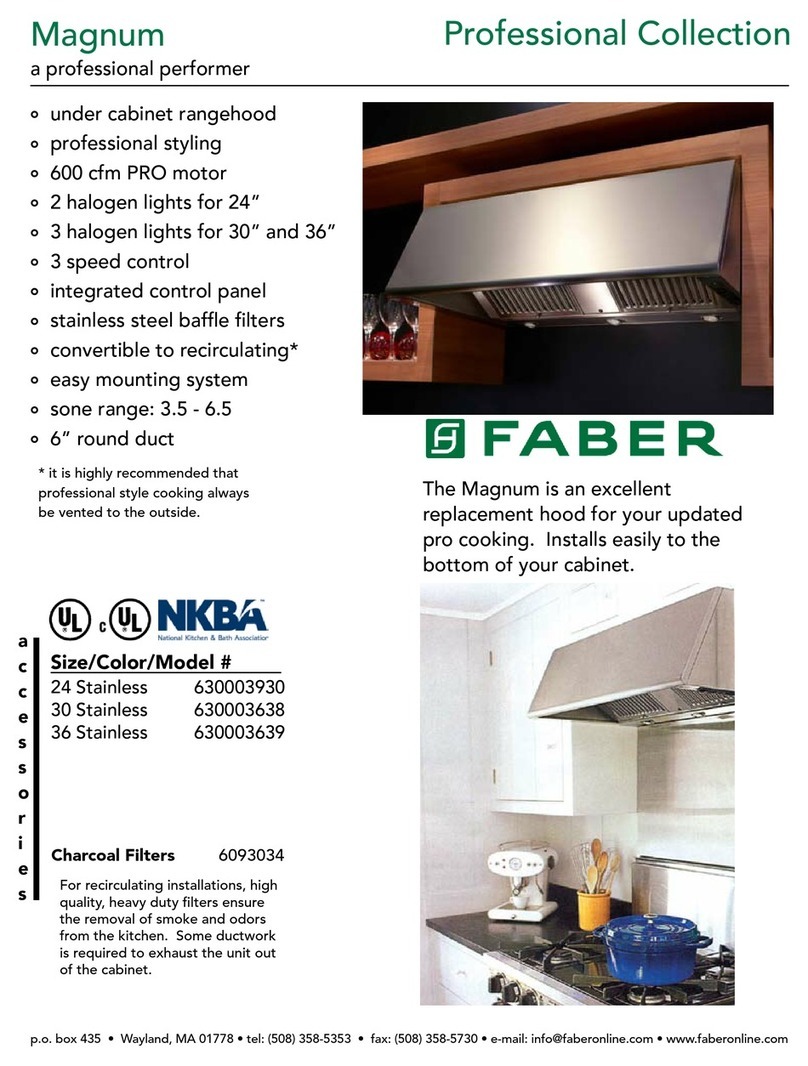
Faber
Faber Magnum 630003930 Brochure & specs
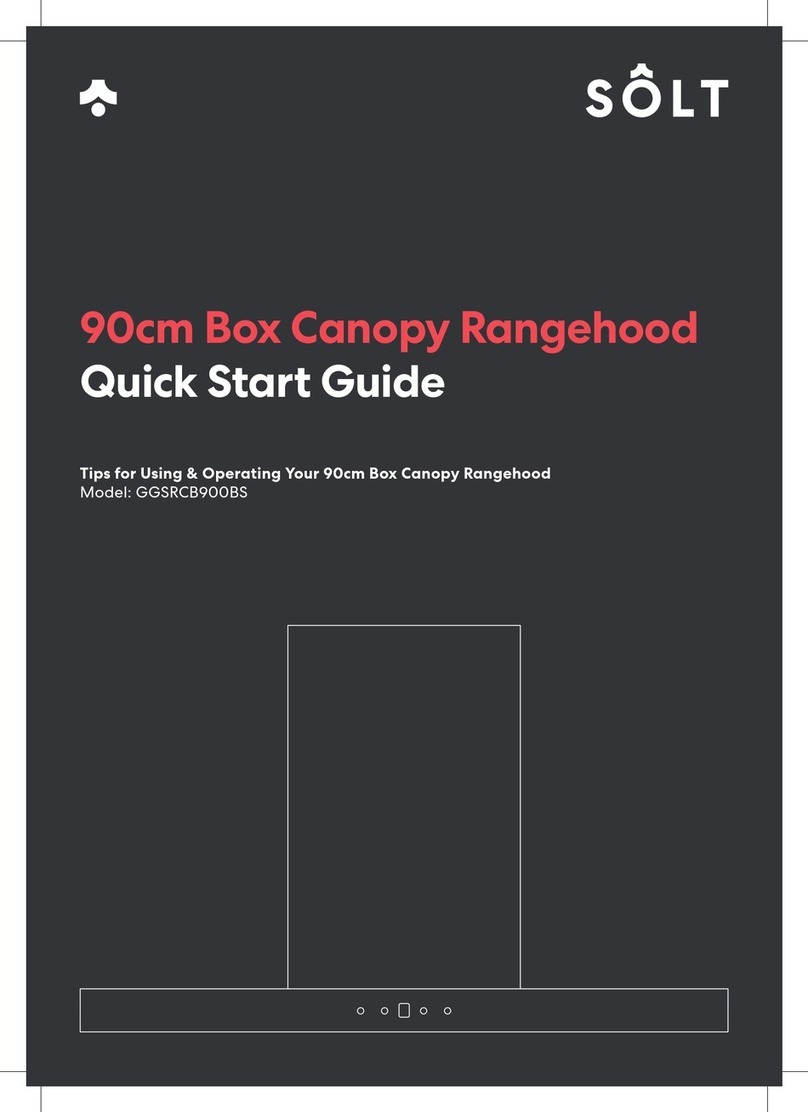
Solt
Solt GGSRCB900BS quick start guide

Smeg
Smeg Victoria Aesthetic KT90PE Instruction booklet
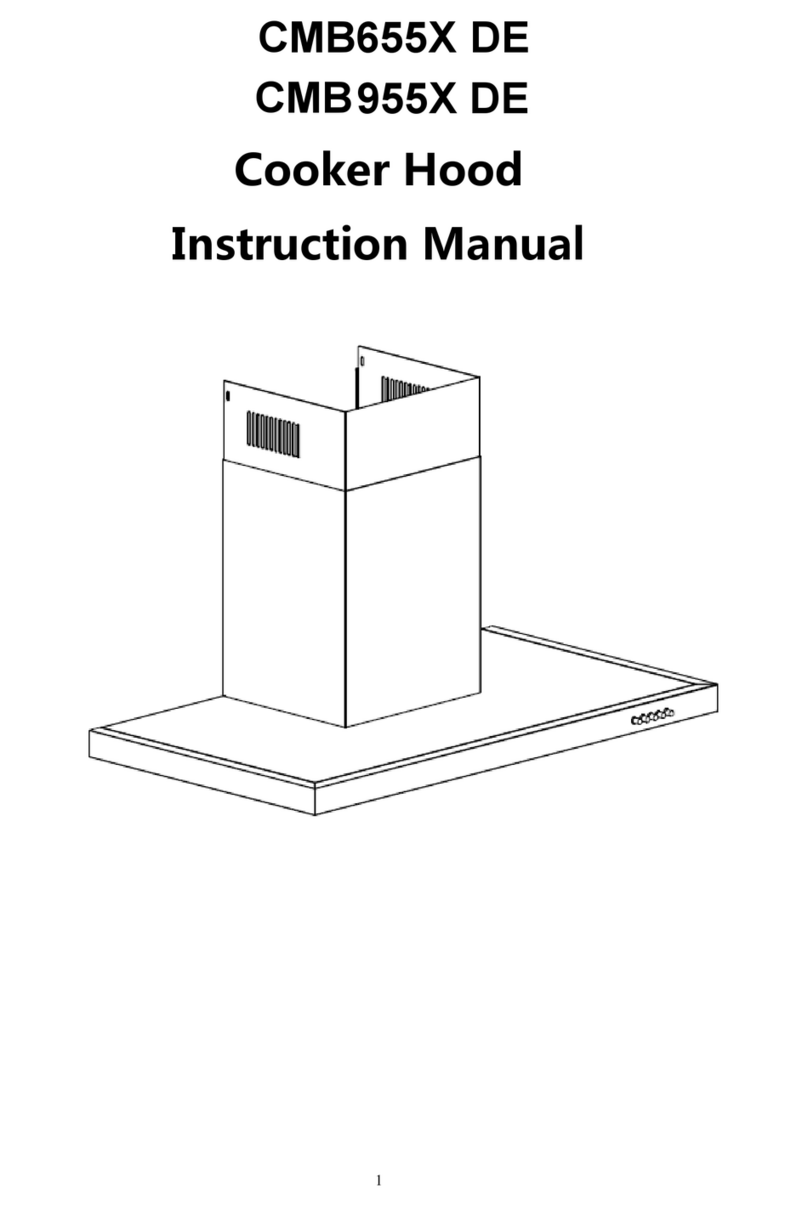
Candy
Candy CMB 955X DE instruction manual


